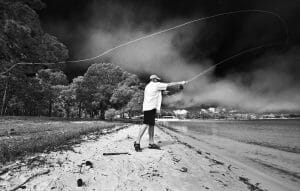
 How Do I Do It?
How Do I Do It?
The proper fly rod will either make your trip a lot of fun or a complete hassle. It’s important, that when you first begin, you make all of your selections correctly; otherwise you are in store for a whole world of frustration. There are a lot of things you need to take into consideration when you buy a rod. Does it fit the target species you are trying to catch? Does it fit the size fly you want to use? Will it survive the conditions you will be in? There are a handful of important things you need to know before choosing your fly fishing rod, and here they are.
Weight
When we talk about weight, we mean the weight of the line that the rod is designed to cast. Lines have different thicknesses and weights depending on what they are made to catch. Basically each rod is designed to cast a certain amount of line. Rods are designed to be powerful enough to get the line out effectively.
If you are using line that is too light for your rod then your rod will struggle when you cast it and it won’t be as much fun. If the rod is too heavy then the action won’t work as effectively so you won’t get the cast you will need either. The line won’t be easy to move because of the stiffness.
Remember this when you buy your equipment!
Length
On average fly rods are about 8 to 9 feet in range. The rods that are longer have a bit more casting power and work better with the bigger catches. If you want something in the middle, then an 8 footer is your best bet. However, if it’s anything smaller then it’ll work well for small stream fishing or for fishing smaller species.
Action
When casting or fighting a fish, the tip will become slightly bent. It has a stiffer feel to it and it has greater casting power which enables it to cut through the wind or to cast a further difference. The fast action will also save your arm because it doesn’t require as much power to push.
A rod that is medium or moderate bends half way down the rod when it is casting or fighting with a fish. These rods are still a solid choice, but your cast won’t go as far.
The action is a big part of how a rod feels. If you pay attention to what the rod is made for then you shouldn’t have a problem. You should also know that rods come in medium-fast and medium-slow, you can think of this as the middle ground between the three actions.
Pieces of the Rod
Fly rods come in many different pieces. The only difference is how many pieces the rod can break down into because this specifically impacts storage. An eight piece rod will break down better than a solid 9 foot rod.
People do have their preferences. Sometimes it’s best to fish with a one piece since the body is fully attached. It has been said that the sensitivity and performance of a rod becomes poorer as the breakdowns increase. So 2 to 4 pieces are optimal for the breakdown of a rod, and there is no difference in performance.
Warranty
This depends on the manufacturer. Some of them will provide a lifetime warranty, while others will only provide a warranty that covers the defects of the rod. Some manufactures, like Temple Fork Outfitters, offer a no fault warranty so no matter how it gets damaged all you have to do is send in an extra $30 and it will either get fixed or replaced. It may not seem significant right now when you are only just in the process of buying it, but once you accidently get it slammed on by a door you’ll see how important it is.
Conclusion
Each fly rod has its own characteristics and hopefully this information helps you out a little bit when you go out shopping for your first rod. Also check out the 5 best fly rods for the money 2017 article!
Thanks for reading!







